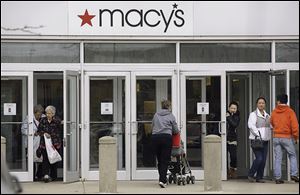
Retail sales show little growth
Underemployment in U.S., joblessness beset economy
8/14/2014
Earnings at Macy’s, the second-largest U.S. department-store firm, trailed expectations after discounts to lure shoppers eroded profit.
WASHINGTON — U.S. retail sales stalled in July as discounting by merchants such as Macy’s Inc. failed to counter the effects of feeble wage growth.
Purchases were little changed, the weakest performance in six months, after a 0.2 percent advance in June, the Commerce Department said Wednesday. Gains in sales of clothing, groceries, and personal-care goods were offset by declines at department, electronics, and furniture stores.
Greater employment opportunities this year have yet to translate into the incomes needed to invigorate American consumers, a sign the economy will have trouble sustaining the second-quarter pickup in growth. Legions of long-term unemployed and discouraged workers are among the reasons wages aren’t picking up more quickly, giving Federal Reserve policy makers room to keep interest rates low.
“There’s no sign of momentum or enthusiasm out of the consumer right now,” said Stephen Stanley, chief economist at Pierpont Securities LLC in Stamford, Conn., who accurately forecast Wednesday’s sales figure. “Employment has picked up in recent months but you’re not seeing the growth in hours worked that would generate big increases in paychecks.”
Central bankers in the United States and Europe are taking worker pay and its effect on demand into account as they consider changes in monetary policy.
The U.K. central bank cut its economic forecast Wednesday after labor-market data showed wages fell an annualized 0.2 percent in the second quarter, the first decline since 2009. The bank now projects pay growth of 1.25 percent in the fourth quarter, down from an earlier estimate of 2.5 percent.
Fed officials are also focusing on the U.S. labor market in determining when to end monetary stimulus. Fed Vice Chairman Stanley Fischer said this week that the share of working-age people in the U.S. labor force, near the lowest since 1978, is a “source of concern” because it may contribute to a slowdown in the longer-run output of the economy.
The U.S. labor market, while improving, has yet to return to full strength. While employers added more than 200,000 jobs in each of the past six months, the best performance since 1997, and job openings rose in June to the highest in more than 13 years, there are still pockets of slack in the job market.
There were 3.16 million people unemployed for 27 weeks or more in July, compared with 1.54 million on average in the five years leading up to the last recession. A measure of underemployment — which takes into account people working part-time who would prefer a full-time job and those who’ve stopped looking but would take a position if one were available — rose to 12.2 percent last month. It averaged 9 percent from 2003 through 2007.
Macy’s, the second-largest U.S. department-store firm, on Wednesday posted earnings that trailed analysts’ estimates after discounts to lure shoppers eroded profit margins. Sales at stores open at least a year rose 3.4 percent in the quarter ended Aug. 2, missing the projection of 3.9 percent. Macy’s also cut its full-year forecast to 2 to 2.5 percent from a previous projection of as much as 3 percent.